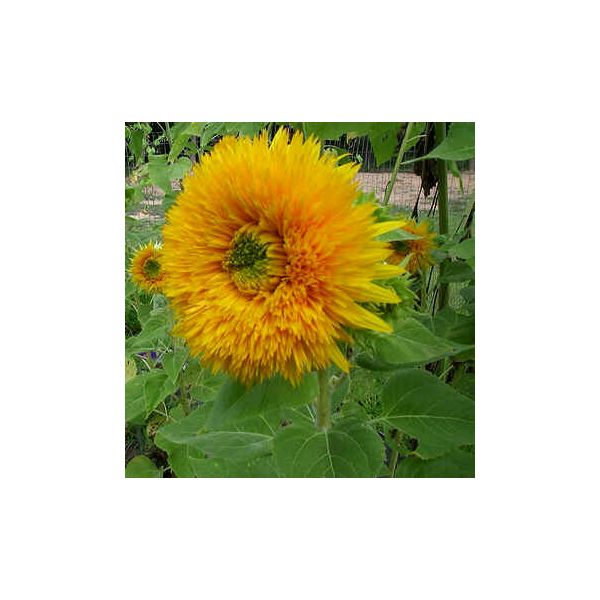Graines Helianthus Géant Double Soleil Doré
Graines Helianthus Géant Double Soleil Doré
Une plus grande et plus grosse version du tournesol Teddy Bear !

Delivery
All orders shipped with UPS Express.
Always free shipping for orders over US $250.
All orders are shipped with a UPS tracking number.
Returns
Items returned within 14 days of their original shipment date in same as new condition will be eligible for a full refund or store credit.
Refunds will be charged back to the original form of payment used for purchase.
Customer is responsible for shipping charges when making returns and shipping/handling fees of original purchase is non-refundable.
All sale items are final purchases.
Help
Give us a shout if you have any other questions and/or concerns.
Email: [email protected]
Phone: +1 (23) 456 789
Availability: En stock
SKU
Helianthus Giant Double Sungold
Le tournesol Sungold géant double est très impressionnant et est un choix merveilleux comme fond de jardin pour d'autres variétés de tournesol, ou comme écran pour créer votre propre jardin privé, ou tout simplement pour leur beauté.
Une plus grande et plus grosse version du tournesol Teddy Bear ! Le Sungold géant se charge de magnifiques doubles fleurs de 6-8 pouces de diamètre, des fleurs jaune or avec les pétales piqués, qui dureront plus longtemps sur la tige que les tournesols avec fleurs simples.
Ces grands tournesols atteindront environ 5-6 pi de hauteur et ses tiges embranchées fleurissantes sont très vigoureuses. Les tournesols fleurissent du milieu de l'été jusqu’au gel et font d’excellente fleurs a coupées qui sont très durable.
Zones de robustesse :
3-9 (- 37c/-35f, -5c/25f). Tous les tournesols préfèrent le plein soleil et sont tolérant à la sécheresse. Ils fleurissent très bien dans n’importe quel bon sol. Pour favoriser les racines profondes et les tiges fortes, arrosez profondément mais pas souvent. Une ou deux tasses d’engrais complet par 3m (10 pi) de rang de semences est suffisante pour l'année ; une sur-fertilisation peut causer la rupture des tiges en automne.
| Nom commun | Sunflower |
|---|---|
| Espèce | Helianthus annuus |
| Cultivar | Giant Double Sungold |
| Germination | Sow the Sungold seeds at 1cm deep, in any good soil and leave10cm between the seeds. The best sowing period is from mid-April through mid-May. Germination should occur in 14-21 days and they should be ready to bloom in about 75-110 days. For continuous flowers, seed every two weeks. Once they start to grow, thin to 45 cm (2ft), leaving only the strongest plants, so they get enough room to grow. As ornamental cut flower varieties bloom, keep the spent flowers picked to encourage more blossoms. For the vase, cut the fresh flowers in the morning just after they open. Use a clean knife, a clean vase and a few drops of bleach in the water to keep it fresh. To dry sunflower seeds, cut the heads off when they begin to yellow at the back and hang them upside down in a dry location away from rodents and birds. Once dry, rub the seeds off and soak overnight in 4L (1 gal) of water with 1 cup of salt in it. Dry in a 250F oven for 4-5 hours and store in an airtight container. The black-seeded varieties are mainly for oil and birdseed. The grey and white-striped varieties like Giganteus are for drying and eating. Note: What is usually called the flower is actually a head (formally composite flower) of numerous flowers (florets) crowded together. The outer flowers are the ray florets and can be yellow, maroon, orange, or other colors, and are sterile. The florets inside the circular head are called disc florets. The disc florets mature into what are traditionally called "sunflower seeds", but are actually the fruit (an achene) of the plant. The true seeds are encased in an inedible husk. Sunflowers in the bud stage exhibit heliotropism. At sunrise, the faces of most sunflowers are turned towards the east. Over the course of the day, they move to track the sun from east to west, while at night they return to an eastward orientation. This motion is performed by motor cells in the pulvinus, a flexible segment of the stem just below the bud. As the bud stage ends, the stem stiffens and the blooming stage is reached. Now the stem is frozen, typically in an eastward orientation. The stem and leaves lose their green color. The wild sunflower typically does not turn toward the sun; its flowering heads may face many directions when mature. However, the leaves typically exhibit some heliotropism. |
| Price View | Tranche de prix |

